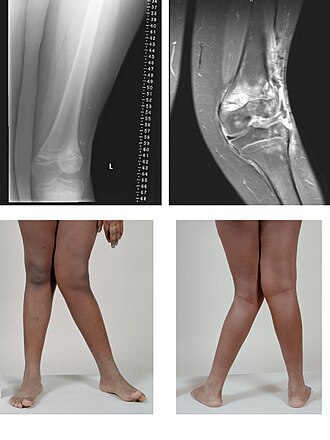Rickets is a pediatric skeletal disorder resulting from defective mineralization of the growth plates due to prolonged deficiency of vitamin D, calcium, or phosphate. The condition leads to bone softening and deformities, most commonly in children aged 6 months to 3 years, during periods of rapid growth. Unlike osteomalacia, which affects adults, rickets occurs in the growing skeleton and is largely preventable.

Causes and Risk Factors of Rickets
Vitamin D Deficiency
Vitamin D is essential for calcium and phosphate absorption from the gastrointestinal tract. Deficiency may arise from:
- Inadequate sunlight exposure
- Poor dietary intake
- Exclusive breastfeeding without supplementation
- Dark skin (reduces vitamin D synthesis)
- Living in northern latitudes or high-pollution areas
Dietary Calcium or Phosphate Deficiency
Insufficient calcium or phosphate can contribute to impaired bone mineralization, particularly in populations with limited access to dairy products or those with restricted diets.
Genetic and Metabolic Disorders
- Vitamin D–dependent rickets type 1 and 2: Inherited forms that impair vitamin D metabolism
- X-linked hypophosphatemic rickets: A genetic condition causing renal phosphate wasting
Malabsorption Syndromes
- Celiac disease, inflammatory bowel disease, or pancreatic insufficiency can impair vitamin D and calcium absorption
Clinical Signs and Symptoms of Rickets
| System | Symptoms and Signs |
|---|---|
| Skeletal | Bowed legs (genu varum), knock knees (genu valgum), rachitic rosary |
| Muscular | Muscle weakness, delayed motor milestones |
| Growth | Stunted growth, delayed fontanelle closure |
| Dental | Delayed tooth eruption, enamel defects |
| Neurological | Seizures (due to hypocalcemia), irritability |
Diagnostic Evaluation of Rickets
Clinical Examination
Physical signs such as widened wrists, frontal bossing, and costochondral swelling (rachitic rosary) are indicative. A thorough history of dietary habits and sun exposure is essential.
Laboratory Investigations
| Test | Expected Findings |
|---|---|
| Serum calcium | Low or normal |
| Serum phosphate | Low |
| Alkaline phosphatase | Elevated |
| 25-hydroxyvitamin D | Low (primary indicator of vitamin D status) |
| Parathyroid hormone (PTH) | Elevated (secondary hyperparathyroidism) |
Radiographic Findings
- Widening and cupping of metaphyses
- Frayed growth plates
- Looser’s zones (pseudofractures)
Treatment and Management of Rickets
Vitamin D Supplementation
- Nutritional rickets: 2,000 IU/day of vitamin D for 6–12 weeks, then maintenance dose (400–600 IU/day)
- Stoss therapy: Single high dose (e.g., 600,000 IU) under medical supervision for rapid correction
Calcium Supplementation
In cases of combined calcium and vitamin D deficiency, calcium supplementation is crucial:
- Children over 1 year: 500–1,000 mg/day based on age and dietary intake
Treating Underlying Causes
- Malabsorption: Address primary gastrointestinal disorder
- Genetic rickets: Requires phosphate supplements and calcitriol (active vitamin D)
Dietary and Lifestyle Recommendations
- Sunlight exposure: 15–30 minutes/day on face and arms, without sunscreen, especially in the morning or late afternoon
- Dietary sources of vitamin D and calcium:
- Fortified dairy and cereals
- Fatty fish (salmon, mackerel)
- Egg yolks and beef liver
- Leafy greens, tofu, and legumes
Preventing Rickets: Public Health and Clinical Guidelines
For Infants and Children
- Exclusive breastfed infants should receive 400 IU/day of vitamin D starting in the first few days of life
- Encourage outdoor play and physical activity
For High-Risk Populations
- Supplementation for children with limited sun exposure or darker skin tones
- Routine screening in children with chronic illnesses or special diets
Complications of Untreated Rickets
If left untreated, rickets can lead to:
- Permanent skeletal deformities
- Short stature
- Fractures and bone pain
- Dental abnormalities
- Hypocalcemic seizures and cardiomyopathy
Prognosis and Long-Term Outlook
With early diagnosis and proper treatment, rickets can be completely reversed. Skeletal deformities typically improve within months, and growth normalizes with appropriate therapy. However, late treatment may result in permanent bone abnormalities.
Rickets remains a global health concern, especially in underprivileged regions. Preventative strategies, timely supplementation, dietary improvements, and education are vital in eliminating this entirely preventable disorder. Health professionals must maintain a high index of suspicion for early signs to ensure prompt intervention and optimal child development.

